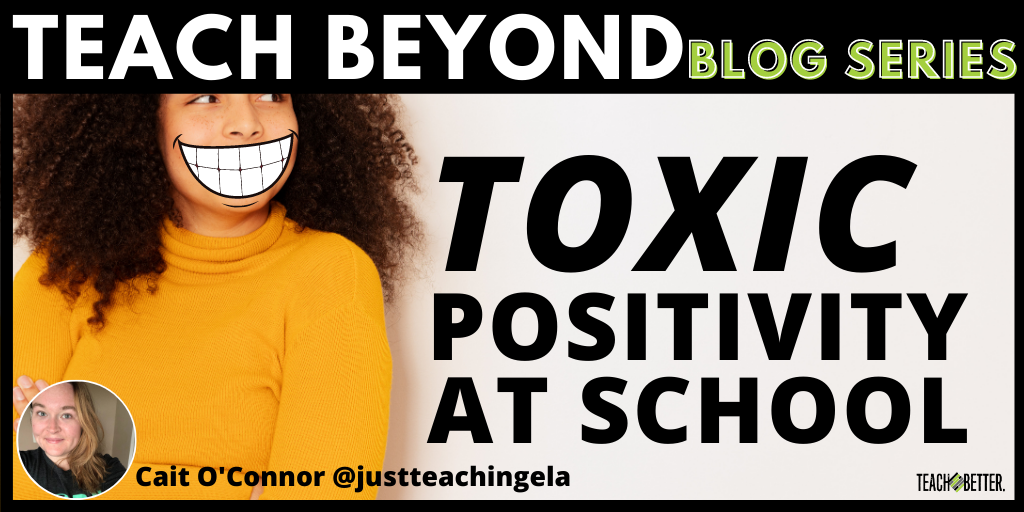TL;DR:
- Toxic positivity does more harm than good. Having a purely positive mindset is a privilege, and does not reflect everyone’s realities.
- It is important to be realistic about the situations and emotions that are present.
- Telling students to see the glass as half full will not wash away their anxieties.
Welcome to Teach Beyond!
A few weeks ago, I moderated my first #MasteryChat and I wanted to do more. For those of you who missed out on Beyond Listening, my name is Cait O’Connor and I am an English/ENL teacher in grades 9 & 12. I currently serve in upstate New York. One of my dearest (of many) passions is social justice and how it applies to education.
I am so looking forward to bringing this passion for social justice to the Teach Better Team through this new series, Teach Beyond. I hope to offer teachers in the Teach Better family (and beyond!) insights into different topics of identity, intersection, and how to best implement social justice into their classrooms.
It’s important to see the good in things, but educators must understand and reflect on the fact that for many, a purely positive mindset is a privilege, and so many students have realities that are not all positive all the time. Share on XHow are you coping with our shared reality?
With so much going on in the world, it’s important to soak up all the positivity that we can find. Every day at school during a pandemic feels like a month went by. It’s really easy to burn out when things are constantly changing. Some days, my lesson plans feel like they should be done on an Etch-a-Sketch.
Each day, though, I engage with the same people for some reality-checking and good energy exchange. I take a few minutes to breathe in and out. I listen to the sound of my fish tank in the background or the dryer running and just observe, observe, observe. Positive news, images, quotes, and people help to build resilience. That is, the ability to tolerate when things aren’t so positive or manageable (as they are bound to be).
Alongside the act of engaging with positive people, places, and things, it’s also important to be realistic about the situations and emotions that are present, with or without a global pandemic to act as a foreground to our personal, professional, and educational lives.
What is ‘toxic positivity’?
Toxic positivity can take a variety of forms, from “good vibes only” (denying students their feelings) or even bypassing systemic issues. It’s important to see the good in things, but educators must understand and reflect on the fact that for many, a purely positive mindset is a privilege, and so many students have realities that are not all positive all the time.

What does toxic positivity look/sound/feel like?
Toxic positivity has many faces, even in the area of education. It shows up in how teachers interact with students and how they interact with each other.
Ultimately, toxic positivity leads to us hearing and seeing each other less, and leaves those affected by it feeling silenced. Toxic positivity prevents us from teaching beyond and from having the world we all want to be a part of.
Aside from “positive vibes only” (a form of spiritual bypassing), toxic positivity could mean comparing a person’s situation to your own if they are trying to seek out comfort or advice. It could also mean using “should” or “have you tried…?” statements. I don’t need to remind y’all that we are facing a global public health crisis and persistent racial, gender, economic, medical, and other forms of social inequality.
It’s important that we listen to one another because it’s more than likely that your colleagues and students are experiencing things that need attention, compassion, and care.
The impact of toxic positivity.
“Good vibes only” might sound well-intentioned. It might cause people to put their feelings or experiences into focus and express gratitude. But what it also can do is create spaces and classrooms where people don’t feel safe enough to share, where there’s an Olympics of comparison, and a cycle of perfectionism in which those who enter the space do not have the freedom or permission to be themselves. We might think we are helping people develop resilience and “grit,” but what we are doing is shutting down the realities of the most marginalized students and teachers.
This happens when we are uncomfortable with those realities and inequalities. And even more so when we are uncomfortable with the fact that we, as teachers, might be the ones perpetuating or participating in them. Toxic positivity can take the form of white (and other forms) privilege and fragility.
If we zoom out of interpersonal experiences with toxic positivity in the classroom and at school and into the larger context of social issues, this can have even larger consequences. Racism and systemic inequality are glaring back at us not only in the U.S., but worldwide. 53% of K-12 students nationwide are students of color. Schools are diversifying as neighborhoods across America do the same. Yet, eighty percent of teachers nationwide are white.
The limits of our understanding.
This is not to say that white teachers or teachers with other forms of intersectional privilege can’t relate to students who are different from them. However, living in one community and teaching in another limits our understanding of the students we teach; the sooner educators accept this, the better we can serve kids without making it about us. After all, the town or neighborhood continues to do its thing, even after we leave.
Those kids go home to their families, who experience a variety of experiences you don’t know about or can’t imagine, no matter how many times you’ve watched Freedom Writers or driven through “that neighborhood” or smiled at somebody else’s children.
This creates a dissonance between the teachers and the students. It may even (and often does) create a culture of compliance and authority rather than community and collaboration. This is especially common in schools and neighborhoods with high populations of Black, Latinx, indigenous, immigrant, Asian, or Desi students. These environments produce students who are the ideal student/consumer rather than a creator, thinker, or innovator. In doing so, they needlessly become victims of saviorism and exist in the vacuum of warm and fuzzies their teacher gets to feel on the drive home each day.
[scroll down to keep reading]
Be heard, not feel heard.
In order to do your best in serving students and connecting them to your content, it’s necessary to learn about the harm and then unlearn the behavior that these power dynamics impose on our classrooms and school communities.
Telling students to see the glass as half full will not wash away their anxieties about deportation, not making rent, being outed to their families, police brutality, violence, or micro-aggressions.
No amount of curricular whitewashing, nationalistic revisionism, or bypassing will cultivate genius, innovation, growth, and self-concept among the students who need us the most—the kids whose histories, realities, bodies, and lives are failed to be seen by many systems. They need us to stand back and pass them the mic while they use the voice that they already had when they entered your room.
Your LGBTQIA+ teacher colleagues, nonbinary teacher colleagues, colleagues of color, colleagues with disabilities and mental illness, migrant colleagues, and working-class colleagues are no exception. Teachers need to be seen too, especially by one another.
All of these things add up to one lesson that teachers must learn as early on in the game as possible: see and hear EVERYONE in your school community at all costs and let them be the teachers, too.
About Cait O’Connor
Cait O’Connor is a fourth-year public school English/ESOL educator in New York, committed to social justice and equity in education and beyond.


